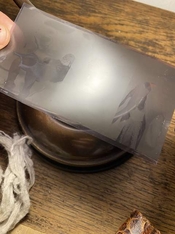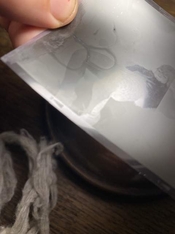Sorry I’m doing this on a phone and this website isn’t really optimized/practical for posting photos and text at the same time on my shitty old iPhone.
I see; it's not a big issue anyway. Don't worry about it!
Thanks for posting the additional photos. I think your problem is that the film dries rapidly with too much water still clinging onto the emulsion. This creates the type of drying marks you're seeing. Here's some things you could try:
* Use distilled water for the last wash step. Simply soak the film in distilled water (instead of water from the tap) for a minute or so before hanging it up to dry.
* Shake the film dry while it's still on the development reel so that there's as little water as possible clinging to the film surface.
* Do not use heat when drying the film. A fan is OK (although watch out for dust). The more rapidly you try to dry the film, the higher the risk of the kind of defects you've observed. If you're using one of those Jobo film drying funnels, try turning on the fan, but not the heat. Alternatively, just hang your film to dry from a clothes line in e.g. a bathroom and give it a few hours.
To fix this affected film, you might try the following:
* Mix a bath of around 0.5% acetic acid. Wash the film in this bath (use e.g. trays to process cut strips of film).
* Now thoroughly wash the film to remove any acid, and give it the final bath in distilled water and the drying treatment as outlined above.
The acid will help dissolve the calcium deposits left on the emulsion side.
There's no guarantee of entirely removing these marks. Part of the marks is due to calcium deposits, but part is also a different surface finish of the gelatin layer that resulted from water droplets clinging to the film becoming very hot. This physically alters the gelatin itself, and I'm not entirely sure if this is reversible. If it is, the wash process outlined above should help.
Good luck. I dry lots of gelatin (usually in far thicker layers than on regular film) and there's just no way to really rush it. Except for forcing dry air across the surface with a fan, there's not much you can do. Note also that in film and silver gelatin paper manufacturing, no heat is actually used to dry the emulsion. It's all cool or even cold air, but the air is very dry and forced at high speed across the emulsion. You can mimic this a bit in a home setting by taking e.g. a space dehumidifier unit and placing it near the film (turned on evidently) or even running the in-house airconditioning if you have it. This will dry the air, and in turn this will help immensely to speed up drying the gelatin emulsion while not overheating it.
PS: do you know that old story (whose truth is still debated) about Robert Capa's photographs of the landings on D-Day being destroyed by overheating them in a drying cabinet? Your post made me think of that one!







